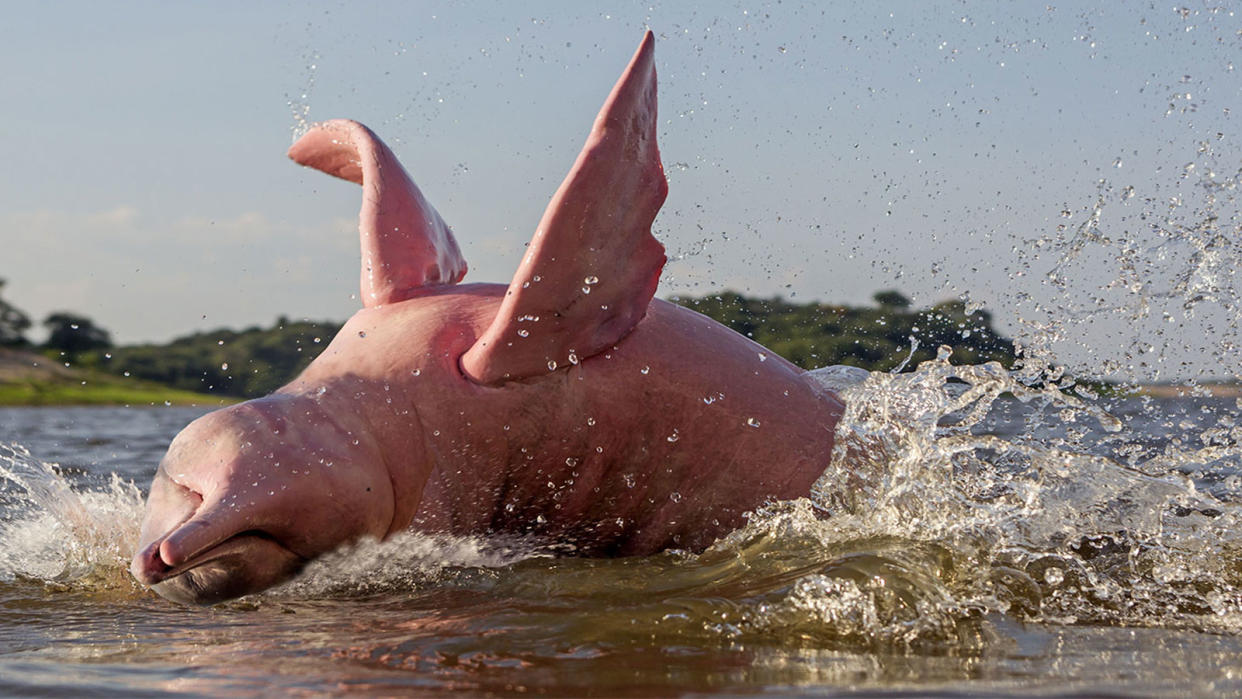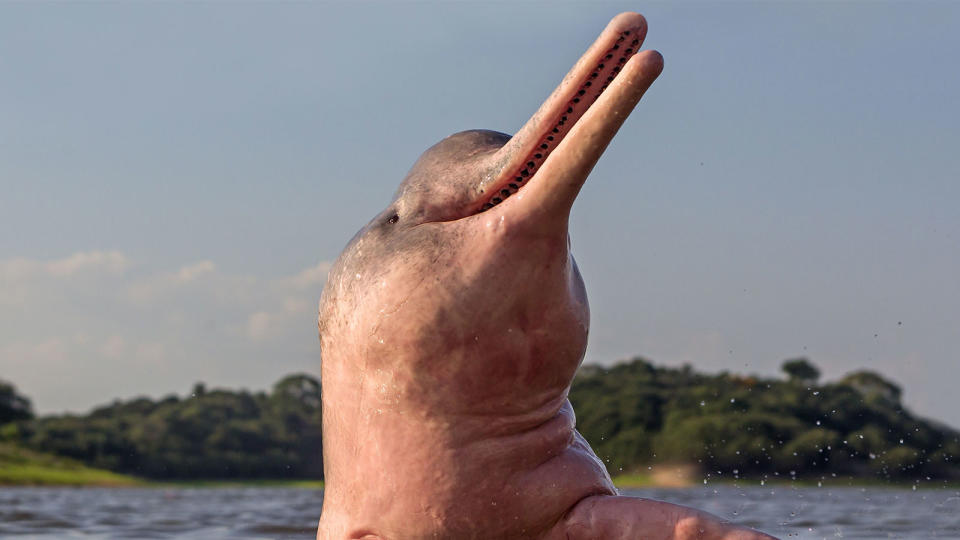Amazon River Dolphins Are Born Grey and Turn Pink

Imagine boating down one of the longest rivers in the world, the Amazon River, minding your own business — calmly keeping an eye out for alarmingly large anacondas — when a curious, flamingo-pink dolphin appears. While they may seem like mythical creatures, pink Amazon river dolphins really do exist.
All About the Largest River Dolphin Species
The Amazon river dolphin (Inia geoffrensis), also known as a boto, is the largest species among river dolphins. It can measure up to 8 feet (2.4 meters) long and weigh around 450 pounds (204 kilograms) — as much as three full kegs of beer!
Size isn't the only thing that sets the Amazon river dolphin apart: This freshwater dolphin, which thrives in the Amazon and Orinoco river, is sometimes shockingly pink.
Although born grey, adult males of the species are easily identified by a distinctly pink hue. Their unusual coloring, which is sometimes wholly pink and sometimes mottled with gray undertones, is believed to be the result of pink scar tissue from dolphin rumbles.
The richer the rosé, the more attractive the males are believed to be — and the older the male, the more the pink coloring he will have.
There's also a theory that salmon-colored dolphins more readily blend in with their surroundings. During heavy rains, rivers along the Amazon basin turn a murky red/pink hue, and with their pink coloring, male dolphins are more easily camouflaged to catch fish and river turtles.

The Amazon's pink river dolphins are one of handful of freshwater dolphin species on Earth; they are aquatic mammals distantly related to saltwater-adapted marine dolphins and toothed whales. In addition to their distinctive pink color, the Amazon's pink river dolphins have another feature that sets them apart from their saltwater cousins.
Unlike marine dolphins, which have a dorsal fin that protrudes from their backs, pink river dolphins have a hump instead. They are carnivorous and dine on any fish, crabs or turtles that hang out in the murky waters of the Peruvian Amazon and flooded forest.
Natural Habitat of the Amazon River Dolphin
Although named after the Amazon River, dolphin populations stretch northwest into the Orinoco River Basins of Venezuela, as well as freshwater sources in Bolivia, Brazil, Colombia, Ecuador, Peru and Guyana. The Amazon river dolphins patrol the murky waters along the regions rivers and lakes the dolphins grow, catch fish, and mate.
Despite populating such a large region of the continent, the Amazon pink river dolphin is endangered by dam construction and water pollution throughout these countries. River dolphin conservation efforts in South America are crucial to ensure that the pink river dolphin and other dolphin species can thrive for generations to come.
Saving the Pink River Dolphin
The Amazonian wetland system, fed by the Amazon River, is a crucial place for pink dolphins to breed, and since 2018 has been granted internationally protected status. The area is home to an astounding variety of rare species. It includes hundreds of plant, bird, reptile, mammal, amphibian and fish species that have thus far been cataloged.
When it comes to protecting Amazon river dolphins, as well as the diverse and irreplaceable wildlife species and indigenous tribes that occupy their habitat, preservation of the Amazon rainforest is paramount. After his election in 2022, Brazilian president Luiz da Silva pledged a fund of $50 million towards Amazon conservation efforts over the next four years.
Numerous other public and private entities have also sprung up within South America and abroad in order to combat the loss of river dolphin habitats and the restoration of the larger Amazon region.
3 Other South American River Dolphins
Although freshwater dolphins are known to exist in India (and formerly in China), the largest and most diverse variety of river dolphin species is localized to South America. Other river dolphins include the Bolivian river dolphin, the Araguaia river dolphin and the La Plata river dolphin.
1. Bolivian River Dolphin
The Bolivian river dolphin occupies a small area of the Bolivian Amazon. This river dolphin species does not to interact or compete often with the Amazon pink river dolphin because rapid river waters separate the two species. Having very little competition for food or shelter within its region, there are believed to up 25,000 Bolivian river dolphins in the wild.
2. Araguaia River Dolphin
This smaller river dolphin variety can be found in the Araguaia river system in Brazil. Also known as the Araguaian boto, this river dolphin bears a lot of familial resemblance to Inia geoffrensis, but the Amazon river dolphin is typically larger and more pink while this species is smaller and greyish-pink. These two were thought to be one species until recent DNA testing classified them separately.
3. La Plata River Dolphin
The La Plata river dolphin is the smallest of all known river dolphin species, only growing about four to five feet long in adulthood. Their territory is also relatively far from the Amazon river dolphin, occupying smaller rivers along the east coast of Brazil, Argentina and Uruguay. These dolphins also have entirely gray skin, with none of the pinkish highlights found on Amazon river dolphins.
Now That's Cool
The Ticuna people, Indigenous to the Brazilian Amazon region, tell of a river dolphin that attended their festivities guised as a human man. The shape-shifting dolphin enchanted a woman and took her to the Amazon River, where she was transformed into a dolphin.
Original article: Amazon River Dolphins Are Born Grey and Turn Pink
Copyright © 2024 HowStuffWorks, a division of InfoSpace Holdings, LLC, a System1 Company


